Laboratory Evaluation of Asphalt Mixture Performance Using Composite Admixtures of Lignin and Glass Fibers
Abstract
1. Introduction
2. Materials
2.1. Asphalt
2.2. Admixture
2.2.1. Lignin Fiber
2.2.2. Glass Fiber
2.3. Aggregate and Gradation
2.3.1. Aggregate and Mineral Filler
2.3.2. Mix Gradation
3. Experimental Plan
3.1. Sample Preparation
- -
- The control asphalt mixture (without additives) (C)
- -
- The lignin fiber (0.3% of the asphalt mix weight) modified asphalt mix (L)
- -
- The glass fiber (0.3% of the asphalt mix weight) modified asphalt mix (G)
- -
- The composite modified asphalt mix (lignin fiber (0.3% of the asphalt mix weight) + glass fiber (0.3% of the asphalt mix weight)) (LG)
3.2. Determination of the Optimum Asphalt Content
3.3. Mixing of Asphalt Mixture
3.4. Asphalt Mixture Performance Tests
3.4.1. Water Stability Performance
Marshall Immersion Test
Freeze–Thaw Splitting Test
3.4.2. Low-Temperature Performance Test
4. Results and Discussion
4.1. Results and Discussion of Marshall Stability Test
4.2. Results of Water Stability Tests
4.2.1. Marshall Immersion Test
4.2.2. Freeze–Thaw Splitting Test
4.2.3. Discussion of Moisture Susceptibility Tests Results (Marshall Immersion and Freeze–Thaw Splitting)
4.3. Results and Discussion of Low-Temperature Three-Point Bending Test
5. Conclusions
- The optimum bitumen content of the mixtures obtained from the Marshall stability test increased by adding lignin and glass fibers because the fiber has a high absorption of bitumen due to its large specific surface area.
- The MSR, TSR, maximum tensile strength, and strain of asphalt mixtures were enhanced by the addition of lignin and glass fibers. Lignin and glass fibers significantly improved the moisture susceptibility and low-temperature resistance.
- Lignin fiber had a greater effect on the bending strength and ultimate bending strain compared to glass fiber due to its large specific area and absorption effect; however, the influence of glass fiber on improving the water stability performance was more significant than that of lignin fiber.
- The asphalt mixture reinforced with composite admixture showed significant improvements with respect to moisture susceptibility and low-temperature stability as compared to the other mixtures.
Author Contributions
Funding
Acknowledgments
Conflicts of Interest
Abbreviations
| C | Control asphalt mix |
| L | Lignin fiber modified asphalt mix |
| G | Glass fiber modified asphalt mix |
| LG | Composite of lignin fiber and glass fiber modified asphalt mix |
| TSR | Tensile strength ratio |
| SMA | Stone matrix asphalt |
| FRAC | Fiber-reinforced asphalt concrete |
| PI | Penetration index |
| TFOT | Thin film oven test |
| O.A.C | Optimum asphalt content |
| MSR | Ratio of residual stability |
| MS2 | Marshall stability after 48 h of water immersion |
| MS1 | Marshall stability of the fresh mixture after 30 min water immersion. |
| RT2 | Splitting strength of frozen–thawed samples |
| RT1 | Splitting strength of fresh samples |
| PT | Indirect tensile loading at failure |
| h | Sample height |
| RB | Maximum flexural stress |
| L | Span length of the beam |
| PB | Ultimate load when the failure occurs |
| b | Width of the beam |
| h | Height of the beam |
| ƐB | Maximum flexural strain |
| d | Deflection of mid-span when the failure occurs |
References
- Zhang, Z.; Jia, M.; Jiao, W.; Qi, B.; Liu, H. Physical properties and microstructures of organic rectorites and their modified asphalts. Constr. Build. Mater. 2018, 171, 33–43. [Google Scholar] [CrossRef]
- Jafarifar, N.; Pilakoutas, K.; Bennett, T. Moisture transport and drying shrinkage properties of steel–fibre-reinforced-concrete. Constr. Build. Mater. 2014, 73, 41–50. [Google Scholar] [CrossRef]
- Park, P.; El-Tawil, S.; Park, S.Y.; Naaman, A.E. Cracking resistance of fiber reinforced asphalt concrete at −20 °C. Constr. Build. Mater. 2015, 81, 47–57. [Google Scholar] [CrossRef]
- Qin, X.; Shen, A.; Guo, Y.; Li, Z.; Lv, Z. Characterization of asphalt mastics reinforced with basalt fibers. Constr. Build. Mater. 2018, 159, 508–516. [Google Scholar] [CrossRef]
- Chen, H.; Xu, Q. Experimental study of fibers in stabilizing and reinforcing asphalt binder. Fuel 2010, 89, 1616–1622. [Google Scholar] [CrossRef]
- Abiola, O.; Kupolati, W.; Sadiku, E.; Ndambuki, J. Utilisation of natural fibre as modifier in bituminous mixes: A review. Constr. Build. Mater. 2014, 54, 305–312. [Google Scholar] [CrossRef]
- Sun, Z.H.; Yang, G.F.; Wang, T.B.; Wang, Z.S. Research on Evaluation Index of Water Stability for Asphalt Mixtures. In Advanced Materials Research; Trans Tech Publications Ltd.: Stafa-Zurich, Switzerland, 2013; pp. 2724–2728. [Google Scholar]
- Mashaan, N.S.; Ali, A.H.; Koting, S.; Karim, M.R. Performance evaluation of crumb rubber modified stone mastic asphalt pavement in Malaysia. Adv. Mater. Sci. Eng. 2013, 2013. [Google Scholar] [CrossRef]
- Yusoff, N.I.M.; Breem, A.A.S.; Alattug, H.N.; Hamim, A.; Ahmad, J. The effects of moisture susceptibility and ageing conditions on nano-silica/polymer-modified asphalt mixtures. Constr. Build. Mater. 2014, 72, 139–147. [Google Scholar] [CrossRef]
- Wang, X.; Qiu, Y.-J.; Xue, S.-Y.; Yang, Y.; Zheng, Y. Study on durability of high-modulus asphalt mixture based on TLA and fibre composite modification technology. Int. J. Pavement Eng. 2018, 19, 930–936. [Google Scholar] [CrossRef]
- Wu, J.; Hong, R.; Gu, C. Influence of fiber type on low-temperature fracture performance of presawed asphalt mixture beams. Adv. Mater. Sci. Eng. 2018, 2018. [Google Scholar] [CrossRef]
- Pszczola, M.; Jaczewski, M.; Rys, D.; Jaskula, P.; Szydlowski, C. Evaluation of asphalt mixture low-temperature performance in bending beam creep test. Materials 2018, 11, 100. [Google Scholar] [CrossRef] [PubMed]
- Rys, D.; Judycki, J.; Pszczola, M.; Jaczewski, M.; Mejlun, L. Comparison of low-temperature cracks intensity on pavements with high modulus asphalt concrete and conventional asphalt concrete bases. Constr. Build. Mater. 2017, 147, 478–487. [Google Scholar] [CrossRef]
- Judycki, J. A new viscoelastic method of calculation of low-temperature thermal stresses in asphalt layers of pavements. Int. J. Pavement Eng. 2018, 19, 24–36. [Google Scholar] [CrossRef]
- Shen, J. Pavement Performance of Asphalt and Asphalt Mixture; People’s Transportation Press: Beijing, China, 2001. [Google Scholar]
- Tan, Y.; Zhang, L.; Xu, H. Evaluation of low-temperature performance of asphalt paving mixtures. Cold Reg. Sci. Technol. 2012, 70, 107–112. [Google Scholar] [CrossRef]
- Kim, S.; Lee, S.-J.; Yun, Y.-B.; Kim, K.W. The use of CRM-modified asphalt mixtures in Korea: Evaluation of high and ambient temperature performance. Constr. Build. Mater. 2014, 67, 244–248. [Google Scholar] [CrossRef]
- Attaelmanan, M.; Feng, C.P.; Al-Hadidy, A. Laboratory evaluation of HMA with high density polyethylene as a modifier. Constr. Build. Mater. 2011, 25, 2764–2770. [Google Scholar] [CrossRef]
- Fu, Z.; Shen, W.; Huang, Y.; Hang, G.; Li, X. Laboratory evaluation of pavement performance using modified asphalt mixture with a new composite reinforcing material. Int. J. Pavement Res. Technol. 2017, 10, 507–516. [Google Scholar] [CrossRef]
- Fu, Z.; Dang, Y.; Guo, B.; Huang, Y. Laboratory investigation on the properties of asphalt mixtures modified with double-adding admixtures and sensitivity analysis. J. Traffic Transp. Eng. (Engl. Ed.) 2016, 3, 412–426. [Google Scholar] [CrossRef]
- Sengoz, B.; Agar, E. Effect of asphalt film thickness on the moisture sensitivity characteristics of hot-mix asphalt. Build. Environ. 2007, 42, 3621–3628. [Google Scholar] [CrossRef]
- Pan, T. A first-principles based chemophysical environment for studying lignins as an asphalt antioxidant. Constr. Build. Mater. 2012, 36, 654–664. [Google Scholar] [CrossRef]
- Gao, D.-Y.; Xia, D.; Li, H.-G.; Tang, J.-Y. Experimental Study on Effects of Cellulose Fiber on the Pavement Performance of OGFC. J. Zhengzhou Univ. (Eng. Sci.) 2008, 3. [Google Scholar]
- Abtahi, S.M.; Sheikhzadeh, M.; Hejazi, S.M. Fiber-reinforced asphalt-concrete–a review. Constr. Build. Mater. 2010, 24, 871–877. [Google Scholar] [CrossRef]
- Najd, A.; Chao, Z.; Ying, G. Experiments of fracture behavior of glass fiber reinforced asphalt concrete. J. Chang. Univ. (Nat. Sci. Ed.) 2005, 25, 28–32. [Google Scholar]
- Tuya, H. The road performance of lignin and rubber powder composite modified asphalt mixture. Highw. Eng. 2014, 39, 170–175. [Google Scholar]
- Xu, G.; Zhao, L.H.; Zhao, J. Research on Performance of Basalt Fiber-Enhanced SMA. In Advanced Materials Research; Trans Tech Publications Ltd.: Stafa-Zurich, Switzerland, 2011; pp. 4323–4327. [Google Scholar]
- Xiong, R.; Fang, J.; Xu, A.; Guan, B.; Liu, Z. Laboratory investigation on the brucite fiber reinforced asphalt binder and asphalt concrete. Constr. Build. Mater. 2015, 83, 44–52. [Google Scholar] [CrossRef]
- Xu, Q.; Chen, H.; Prozzi, J.A. Performance of fiber reinforced asphalt concrete under environmental temperature and water effects. Constr. Build. Mater. 2010, 24, 2003–2010. [Google Scholar] [CrossRef]
- Thanh, D.V.; Feng, C.P.; Long, L.H. Analysis of high temperature stability and water stability of SMA mixture using orthogonal experiments. Int. J. Civ. Struct. Eng. 2011, 2, 635–647. [Google Scholar]
- Zheng, Z.R.; Zhao, C.; Zhao, Y.F.; Song, P. Influence of Double-Doped Admixtures on Asphalt Mixture Performance. In Advanced Materials Research; Tech Publications Ltd.: Stafa-Zurich, Switzerland, 2012; pp. 329–333. [Google Scholar]
- Morea, F.; Zerbino, R. Improvement of asphalt mixture performance with glass macro-fibers. Constr. Build. Mater. 2018, 164, 113–120. [Google Scholar] [CrossRef]
- Yoo, P.J.; Kim, T.W. Strengthening of hot-mix asphalt mixtures reinforced by polypropylene-impregnated multifilament glass fibres and scraps. Constr. Build. Mater. 2015, 75, 415–420. [Google Scholar] [CrossRef]
- Muftah, A.; Bahadori, A.; Bayomy, F.; Kassem, E. Fiber-Reinforced Hot-Mix Asphalt: Idaho Case Study. Transp. Res. Rec. J. Transp. Res. Board 2017, 2633, 98–107. [Google Scholar] [CrossRef]
- Park, K.-S.; Yoo, P.-J.; Ohm, B.-S.; Choi, J.-Y.; Lim, J.-K. A study on plastic deformation resistance test between glass fiber reinforced asphalt and modified SMA mixture. In Proceedings of the 18th International Conference Road Safety on Five Continents (RS5C 2018), Jeju Island, South Korea, 16–18 May 2018. [Google Scholar]
- Shukla, M.; Tiwari, D.; Sitaramanjaneyulu, K. Performance characteristics of fiber modified asphalt concrete mixes. Int. J. Pavement Eng. Asph. Technol. 2014, 15, 38–50. [Google Scholar] [CrossRef]
- Sadeghnejad, M.; Arabani, M.; Taghipoor, M. Predicting the impact of temperature and stress on the glasphalt mixtures’ rutting behavior. Int. J. Pavement Res. Technol. 2018, 11, 300–310. [Google Scholar] [CrossRef]
- Mahrez, A.; Karim, M.R. Rutting characteristics of bituminous mixes reinforced with glass fiber. In Proceedings of the Eastern Asia Society for Transportation Studies the 7th International Conference of Eastern Asia Society for Transportation Studies, Dalian, China, 24–27 September 2007; p. 282. [Google Scholar]
- Guo, Q.; Li, L.; Cheng, Y.; Jiao, Y.; Xu, C. Laboratory evaluation on performance of diatomite and glass fiber compound modified asphalt mixture. Mater. Des. (1980–2015) 2015, 66, 51–59. [Google Scholar] [CrossRef]
- Khabiri, M.M.; Alidadi, M. The Experimental Study of the Effect of Glass and Carbon Fiber on Physical and Micro-Structure Behavior of Asphalt. Int. J. Integr. Eng. 2017, 8, 1–8. [Google Scholar]
- Hua, T. Marshall Stability and Splitting Test of Fiber Reinforced Asphalt Mixture. Shanxi Transp. Sci. Technol. 2010, 1, 9–12. [Google Scholar]
- Luo, D.; Khater, A.; Yue, Y.; Abdelsalam, M.; Zhang, Z.; Li, Y.; Li, J.; Iseley, D.T. The performance of asphalt mixtures modified with lignin fiber and glass fiber: A review. Constr. Build. Mater. 2019, 209, 377–387. [Google Scholar] [CrossRef]
- Yue, Y.; Abdelsalam, M.; Luo, D.; Khater, A.; Musanyufu, J.; Chen, T. Evaluation of the Properties of Asphalt Mixes Modified with Diatomite and Lignin Fiber: A Review. Materials 2019, 12, 400. [Google Scholar] [CrossRef]
- Shen, J.; Li, F.; Chen, J. Technical Specification for Construction of Highway Asphalt Pavements (JTG F40–2004); Communication Press: Beijing, China, 2005. [Google Scholar]
- Morova, N. Investigation of usability of basalt fibers in hot mix asphalt concrete. Constr. Build. Mater. 2013, 47, 175–180. [Google Scholar] [CrossRef]
- Abtahi, S.; Hejazi, S.; Sheikhzadeh, M.; Semnani, D. An investigation on the use of textile materials to mechanical reinforcement of asphalt-concrete (AC) structures and analysis of results by an artificial neural network (ANN). 4th Nat. Cong Civ. Eng. 2008. [Google Scholar]
- Pang, L.; Liu, K.; Wu, S.; Lei, M.; Chen, Z. Effect of LDHs on the aging resistance of crumb rubber modified asphalt. Constr. Build. Mater. 2014, 67, 239–243. [Google Scholar] [CrossRef]
- Research Institute of Highway Ministry of Transport. Standard Test Methods of Bitumen and Bituminous Mixtures for Highway Engineering: JTG E20-2011; China Communications Press: Beijing, China, 2011. [Google Scholar]
- Shen, J.; Li, P.; Sun, Z. Ministry of Communications. JTJ 052-2000 Standard Test Methods of Bitumen and Bituminous Mixtures for Highway Engineering; Communications Press: Beijing, China, 2000. [Google Scholar]
- AASHTO, T. 283-07. Standard Method of Test for Resistance of Compacted Asphalt Mixtures to Moisture-Induced Damage; American Association of State and Highway Transportation Officials: Washington, DC, USA, 2011. [Google Scholar]
- Yin, A.; Yang, X.; Zeng, G.; Gao, H. Fracture simulation of pre-cracked heterogeneous asphalt mixture beam with movable three-point bending load. Constr. Build. Mater. 2014, 65, 232–242. [Google Scholar] [CrossRef]
- Zhu, Z.-H. Study on the Road Performance of Asphalt Mixture with External Fiber. Master’s Thesis, Chang’an University, Xi’an, China, 2004. [Google Scholar]
- Abdelsalam, M.; Yue, Y.; Khater, A.; Luo, D.; Musanyufu, J.; Qin, X. Laboratory Study on the Performance of Asphalt Mixes Modified with a Novel Composite of Diatomite Powder and Lignin Fiber. Appl. Sci. 2020, 10, 5517. [Google Scholar] [CrossRef]
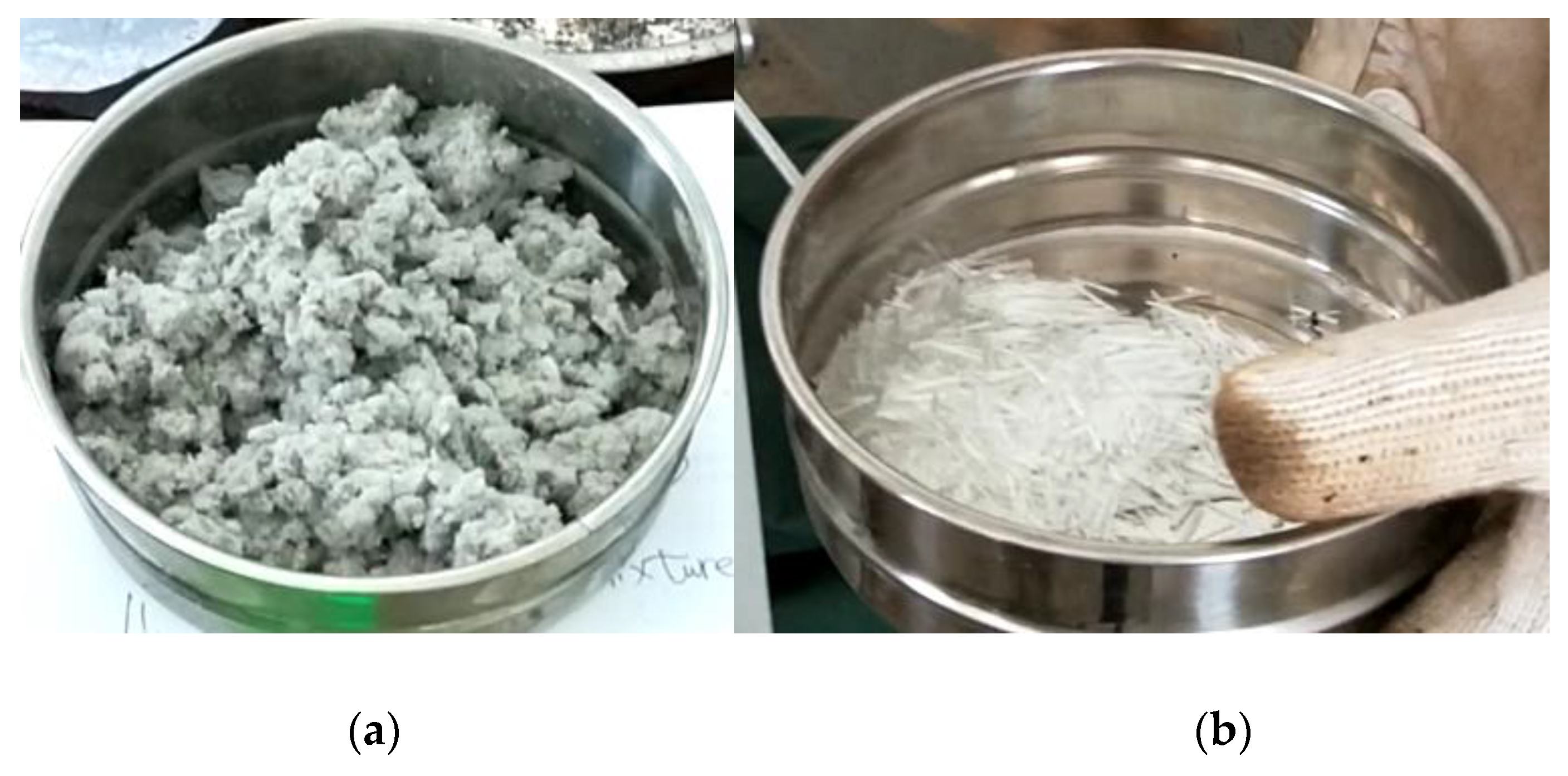
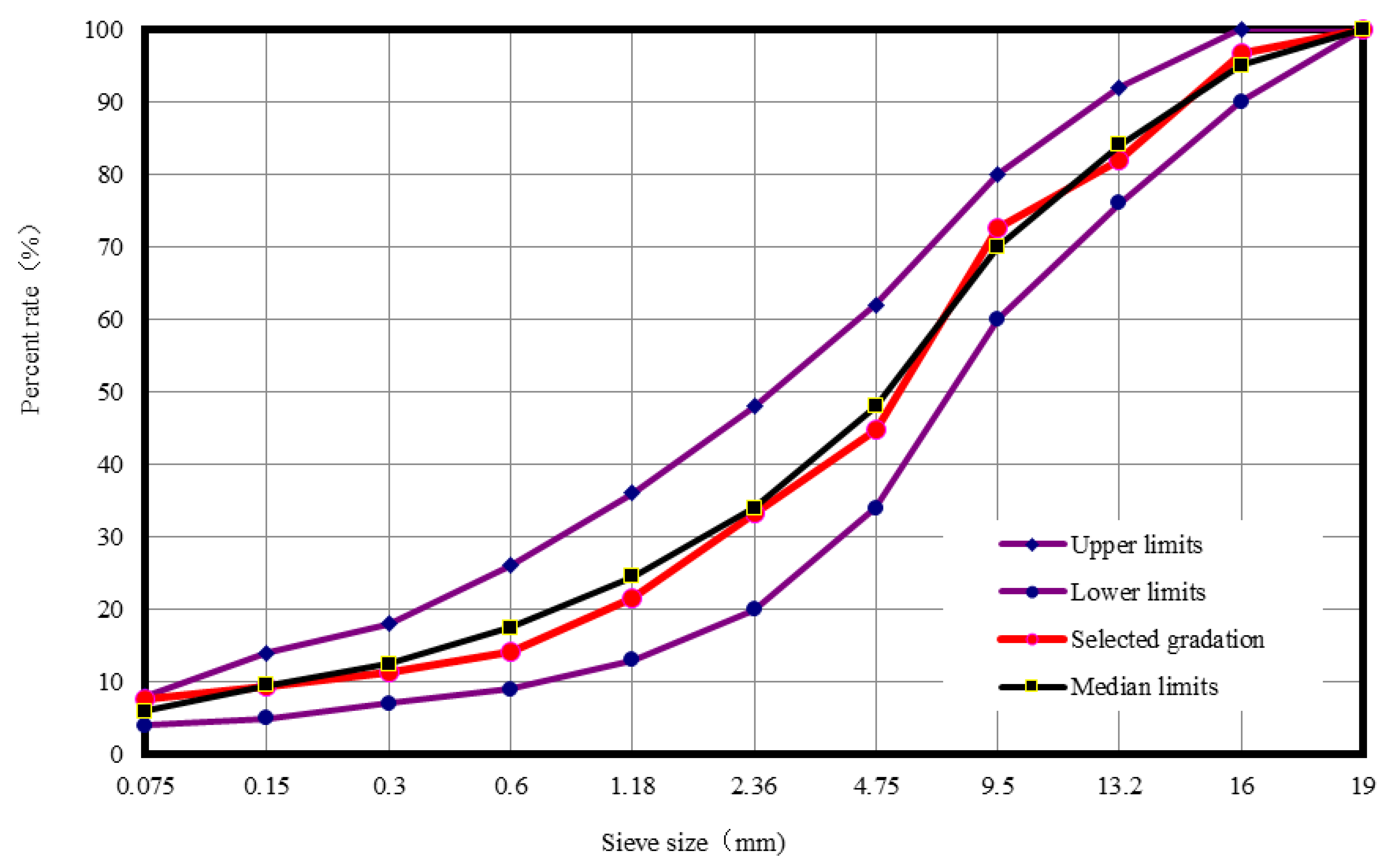
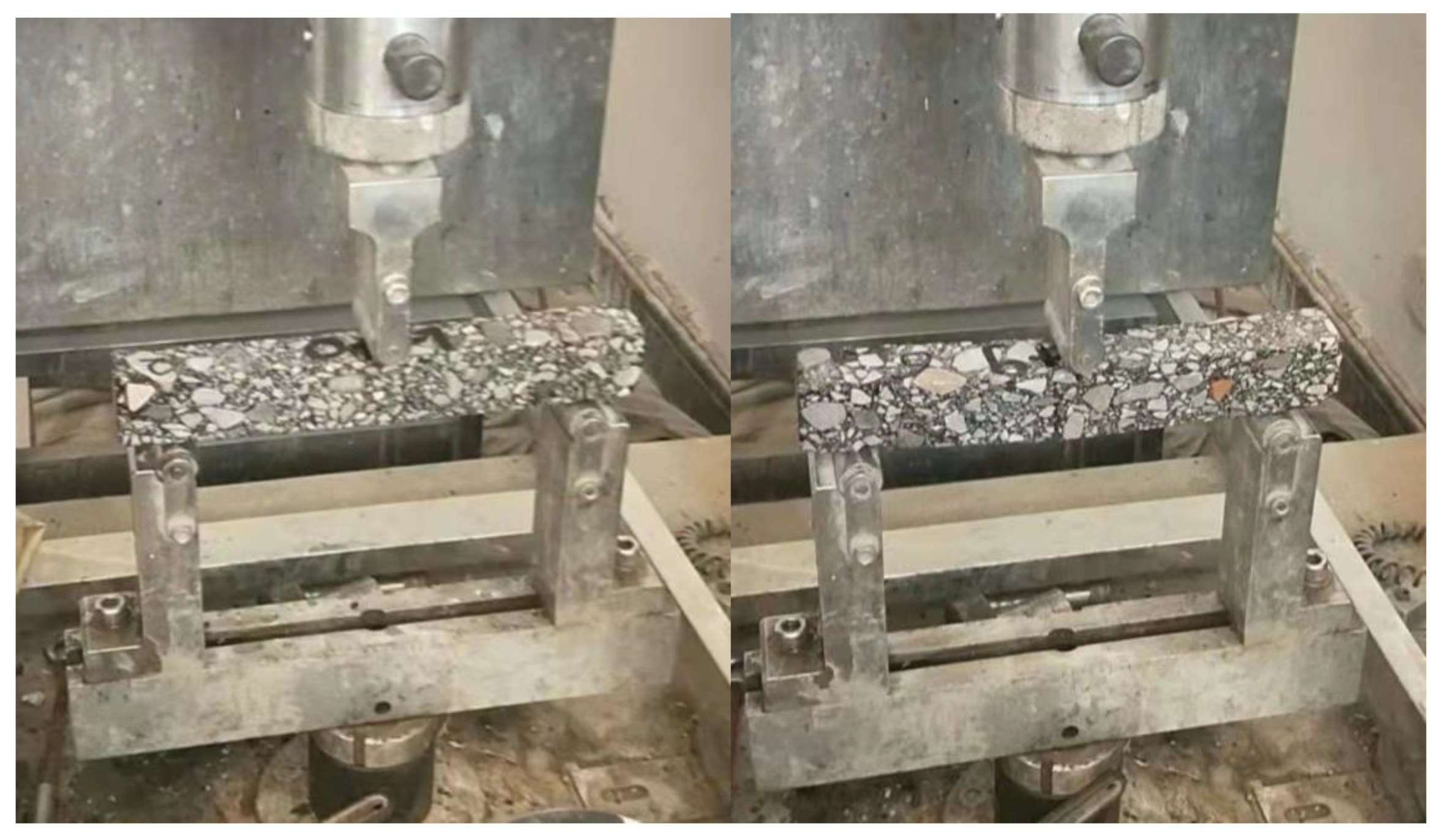

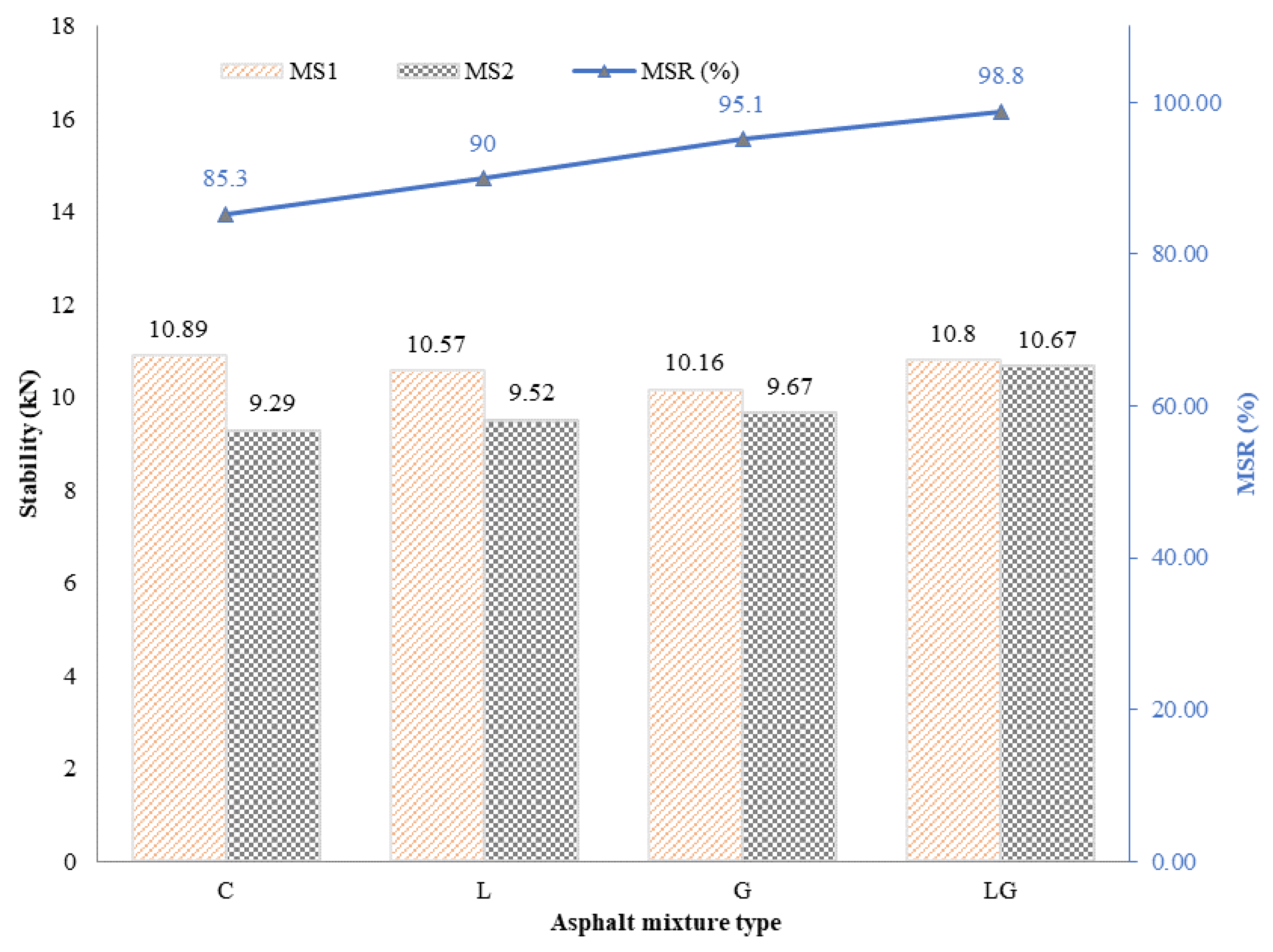
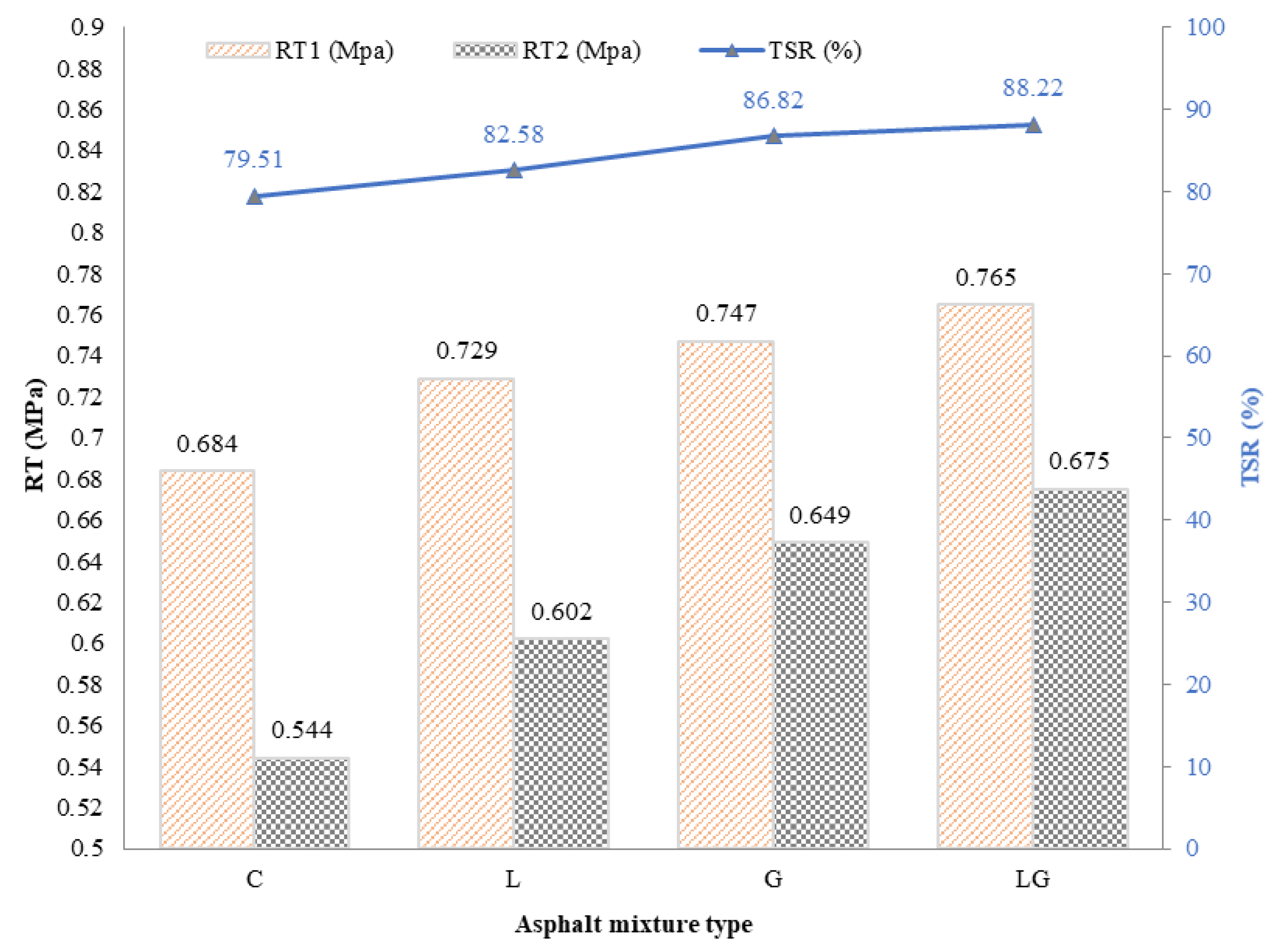

| Item | Penetration (250 C, 100 g, 5 s) (0.1 mm) | Penetration Index (PI) | Softening Point (R&B)/°C | Ductility (15 °C) (cm) | Density (15 °C) (g/cm3) | Thin-Film Oven Test (TFOT) | ||
|---|---|---|---|---|---|---|---|---|
| Mass Loss/% | Residual Penetration Ratio/% | Ductility (15 °C)/cm | ||||||
| Value | 76 | −0.95 | 47 | 134 | 1.034 | 0.043 | 63.40 | 71.40 |
| Standard | 60~80 | −1.0~1.0 | ≥46 | ≥100 | - | ≤ ±0.8 | ≥61 | ≥15 |
| Item | Length (mm) | Specific Area (10−3 m2/gm) | Diameter (mm) | Aspect Ratio (mean) | Density (gm/cm3) | Melt Temperature (°C) |
|---|---|---|---|---|---|---|
| Value | 1.10 | 118.1 | 0.045 | 24 | 1.28 | >200 |
| Item | Length (mm) | Specific Gravity (g/cm3) | Color | Softening Point (°C) | Modulus of Elasticity (GPa) | Tensile Strength (MPa) |
|---|---|---|---|---|---|---|
| Value | 12 | 2.68 | White | 860 | 72 | 1700 |
| Item | Aggregate Size | Los Angeles Abrasion Value/% | Apparent Relative Density | Crushing Value/% | Water Absorption/% | >9.5 mm Needle and Plate Particle Content/% | <9.5 mm Needle and Plate Particle Content/% |
|---|---|---|---|---|---|---|---|
| Standard | ≤30 | ≥2.5 | ≤25 | ≤3 | ≤15 | ≤20 | |
| Measured | 5~10 mm | 15.1 | 2.723 | 9.2 | 0.85 | - | 3.28 |
| 10~20 mm | 13.2 | 2.726 | 9.9 | 0.37 | 6.53 | - |
| Item | Apparent Relative Density | Sand Equivalent/% | Mud Content (Less than 0.075 Content)/% |
|---|---|---|---|
| Standard | >2.5 | >60 | - |
| Measured | 2.692 | 82 | 16.78 |
| Asphalt Mix Type | Control (C) | Lignin Modified (L) | Glass Modified (G) | Lignin and Glass Modified (LG) |
|---|---|---|---|---|
| Fiber type | No fiber | Lignin | Glass | (double addition) Lignin + Glass |
| Percentage of fiber * (%) | - | 0.30 | 0.30 | 0.30 + 0.30 |
| OAC (%) | 4.25 | 4.7 | 4.4 | 4.6 |
| Asphalt Mixture Type | Marshall Immersion Test Results | Freeze–Thaw Splitting Test Results | Low-Temperature Cracking Test Results | |||||
|---|---|---|---|---|---|---|---|---|
| MS1 (kN) | MS2 (kN) | MSR (%) | RT1 (MPa) | RT2 (MPa) | TSR (%) | Bending Stress (MPa) | Bending Strain (µε) | |
| C | 10.89 | 9.29 | 85.3 | 0.684 | 0.544 | 79.51 | 8.20 | 2086.10 |
| L | 10.57 | 9.52 | 90.0 | 0.729 | 0.602 | 82.58 | 9.77 | 2601.66 |
| G | 10.16 | 9.67 | 95.1 | 0.747 | 0.649 | 86.82 | 9.70 | 2484.40 |
| LG | 10.80 | 10.67 | 98.8 | 0.765 | 0.675 | 88.22 | 10.37 | 3104.60 |
Publisher’s Note: MDPI stays neutral with regard to jurisdictional claims in published maps and institutional affiliations. |
© 2021 by the authors. Licensee MDPI, Basel, Switzerland. This article is an open access article distributed under the terms and conditions of the Creative Commons Attribution (CC BY) license (http://creativecommons.org/licenses/by/4.0/).
Share and Cite
Khater, A.; Luo, D.; Abdelsalam, M.; Yue, Y.; Hou, Y.; Ghazy, M. Laboratory Evaluation of Asphalt Mixture Performance Using Composite Admixtures of Lignin and Glass Fibers. Appl. Sci. 2021, 11, 364. https://doi.org/10.3390/app11010364
Khater A, Luo D, Abdelsalam M, Yue Y, Hou Y, Ghazy M. Laboratory Evaluation of Asphalt Mixture Performance Using Composite Admixtures of Lignin and Glass Fibers. Applied Sciences. 2021; 11(1):364. https://doi.org/10.3390/app11010364
Chicago/Turabian StyleKhater, Ahmed, Dong Luo, Moustafa Abdelsalam, Yanchao Yue, Yueqin Hou, and Mohamed Ghazy. 2021. "Laboratory Evaluation of Asphalt Mixture Performance Using Composite Admixtures of Lignin and Glass Fibers" Applied Sciences 11, no. 1: 364. https://doi.org/10.3390/app11010364
APA StyleKhater, A., Luo, D., Abdelsalam, M., Yue, Y., Hou, Y., & Ghazy, M. (2021). Laboratory Evaluation of Asphalt Mixture Performance Using Composite Admixtures of Lignin and Glass Fibers. Applied Sciences, 11(1), 364. https://doi.org/10.3390/app11010364







